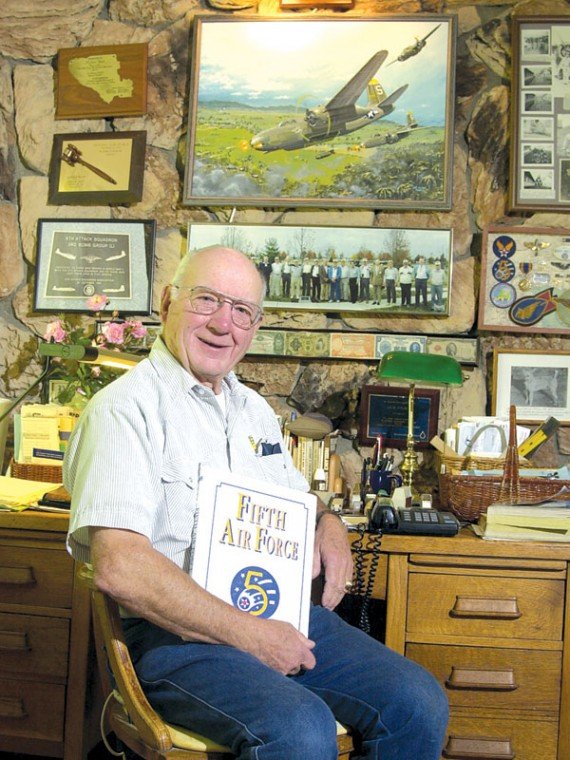GILROY
– World War II veteran and lifetime Gilroyan Jack Sturla is a
quiet and humble man, but he will be the center of attention as
this year’s grand marshal of the Gilroy Memorial Day Parade.
”
It’s quite an honor to be selected,
”
the 84-year-old said, feeling a little uneasy with all of the
attention.
GILROY – World War II veteran and lifetime Gilroyan Jack Sturla is a quiet and humble man, but he will be the center of attention as this year’s grand marshal of the Gilroy Memorial Day Parade.
“It’s quite an honor to be selected,” the 84-year-old said, feeling a little uneasy with all of the attention.
“Some people are flashy,” Sturla’s niece Marcia Linden said. “Jack embodies the simple quality of life. He served his country and came back to live a quiet life of honesty and integrity.”
Jack Sturla will ride in a convertible car near the front of the Memorial Day Parade which begins at 11 a.m. May 26 at the corner of Tenth and Monterey streets. The parade will travel down Tenth Street and conclude at Orchard Street. Preceding the parade, there will be a 9 a.m. service at Gavilan Hills Memorial Park, 129 Fourth St.
Beginning at noon and continuing throughout the afternoon, there will be a Family Fun Day at Christmas Hill Park.
“We wanted to honor a member of the World War II generation,” said Craig Gartman, a member of the Memorial Day Committee that selected Sturla. “Jack Sturla’s remarkable service as an Army pilot, along with his service to the community over the years, made him an easy choice.”
Sturla’s service as a pilot in the Army Air Corps began with rejection.
“I passed the physical and had my hand on the door knob to leave when the sergeant said, ‘Wait a minute, I forgot to take your pulse rate.’ He took it once. Too high. So long.”
But persistence paid off. After nearly two years of service in the Army Medical Corps at Fort Ord in Monterey, Sturla re-applied for the Army Air Corps and this time he was accepted. He graduated with Class 43-B on Feb. 6, 1943, as a Second Lieutenant and was assigned to Will Rogers Field in Oklahoma City.
“I thought I would go into heavy bomber training,” Sturla said. “I never knew why I and 25 other pilots got the choicest assignment of all: A-20 light bombers.”
The A-20 is a strafing bomber intended for combat at near-treetop elevations. Flying at such low levels presents unique dangers.
“Our bomb fuses were timed at five seconds and the line of attack planes were carefully spaced so that we were not killed by our own fire,” Sturla said.
Each A-20 is outfitted with six machine guns and a bomb bay that carries a ton of bombs, all controlled by the pilot. There is no co-pilot in the A-20,” Sturla said, “Just you and a gunner in the back in his own compartment.”
Sturla recalled one close call.
“We were attacking Kavieng Harbor on the island of New Ireland, north of New Guinea,” he said. “We came in, twelve A-20s abreast. I had already dropped a couple of bombs and was zeroing in on a couple of small boats when my plane started going up uncontrollably.
“My rear gunner, rather excitedly, told me that three feet of my rear horizontal stabilizer was missing. I was able to regain control, but I couldn’t keep up with the squadron on the return flight.
It was a lonely two-hour trip home, Sturla said.
“Luckily, no enemy fighters were to be seen,” he said. “It turned out that a huge water spout from an enemy shell exploding in the ocean had caused the damage.
“That’s how low we flew.”
During the year and a half from Sturla’s arrival in the South Pacific until his discharge in August of 1945, Sturla flew 94 combat missions. Due to a shortage of heavy bomber pilots in New Guinea, Sturla was assigned to fly 12 combat missions co-piloting four-engine B-17s with the 63rd Bomb Squadron of the 43rd Bomb Squad, and then 30 combat missions piloting C-47 transport carriers with the 69th Squadron of the 433rd Troop Carrier Group.
However, Sturla missed flying the smaller A-20. After repeated requests, he was transferred to the 3rd Attack Group, 8th Attack Squadron at Doba Dura, New Guinea. He flew 52 combat missions in the A-20, dropping a total of 50 tons of bombs and 55,000 rounds of 50-caliber machine gun ammunition.
“In August of 1945, after four years, four months, and four days, I was discharged from the Army,” Sturla said.
He received the Air Medal and two oak leaf clusters representing 3,000 hours of combat.
After his discharge, Sturla came home to Gilroy to the same Holsclaw Road farm where he was born and where he helped his family grow prunes as a boy. He returned to farming and also served for a period as the manager of the Gavilan Valley Water Conservation District. He is a charter member and former commander of American Legion Post 669 in Gilroy.
In 1948, Sturla married his wife, Dorothy, a Gilroy native. They are very proud to have raised and given a college education to each of their three children – Dave, Juliann and Holly.
But, those who know Sturla best feel his greatest contribution to the community since the war is just being Jack.
“I have known Jack Sturla for 55 years,” said Gordon Hunter, fellow charter member of American Legion Post 669. “He is a hard-working man, a true gentleman and a very good friend.”
“He and Dorothy are beautiful people with no enemies,” longtime friend Al Gagliardi said. “I have never heard Jack say a bad word about anybody.”
Today Sturla and his wife still live on Holsclaw Road. Jack spends his time working the fruit trees on his property and venturing into the surrounding hills that he loves.














